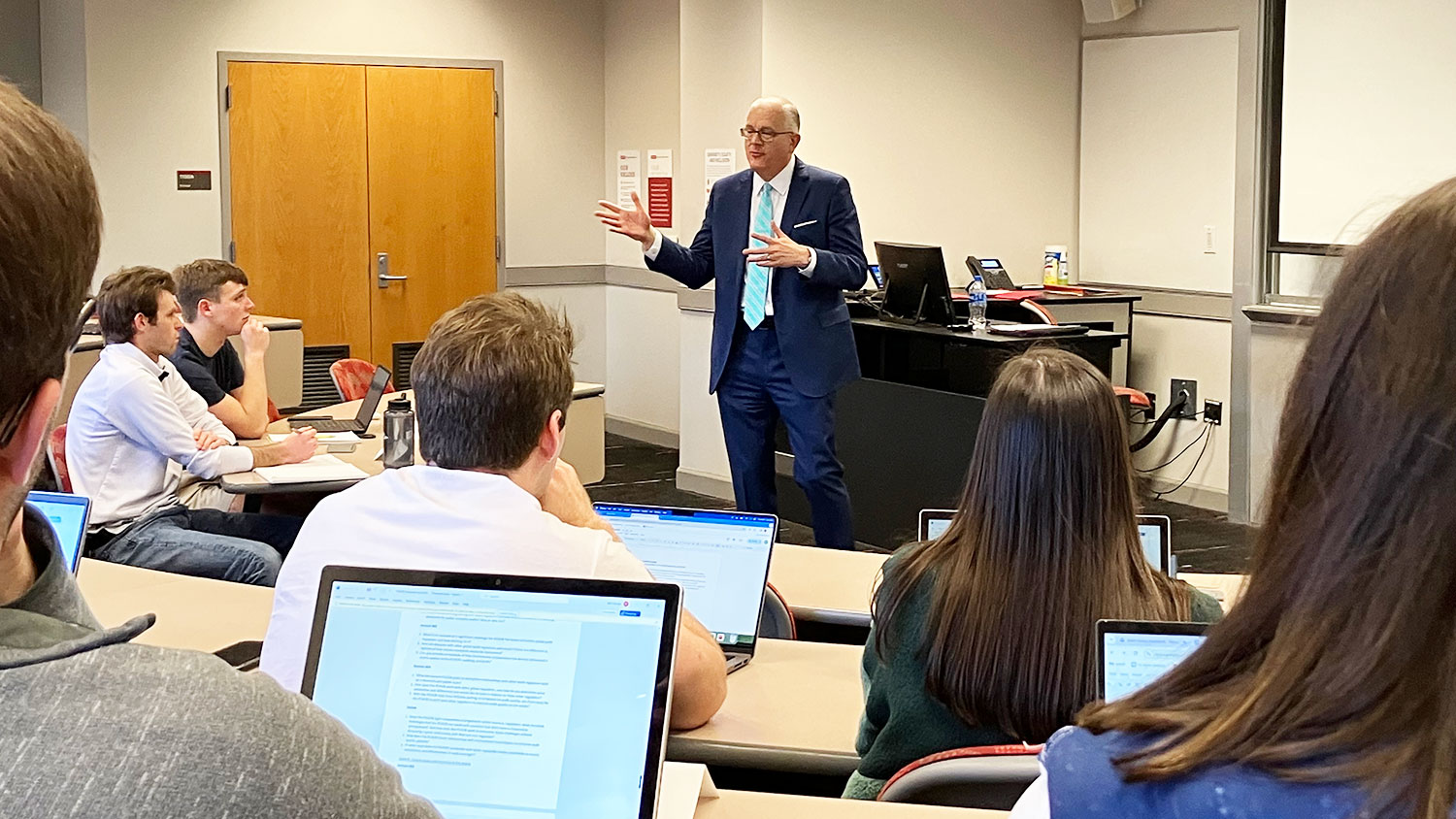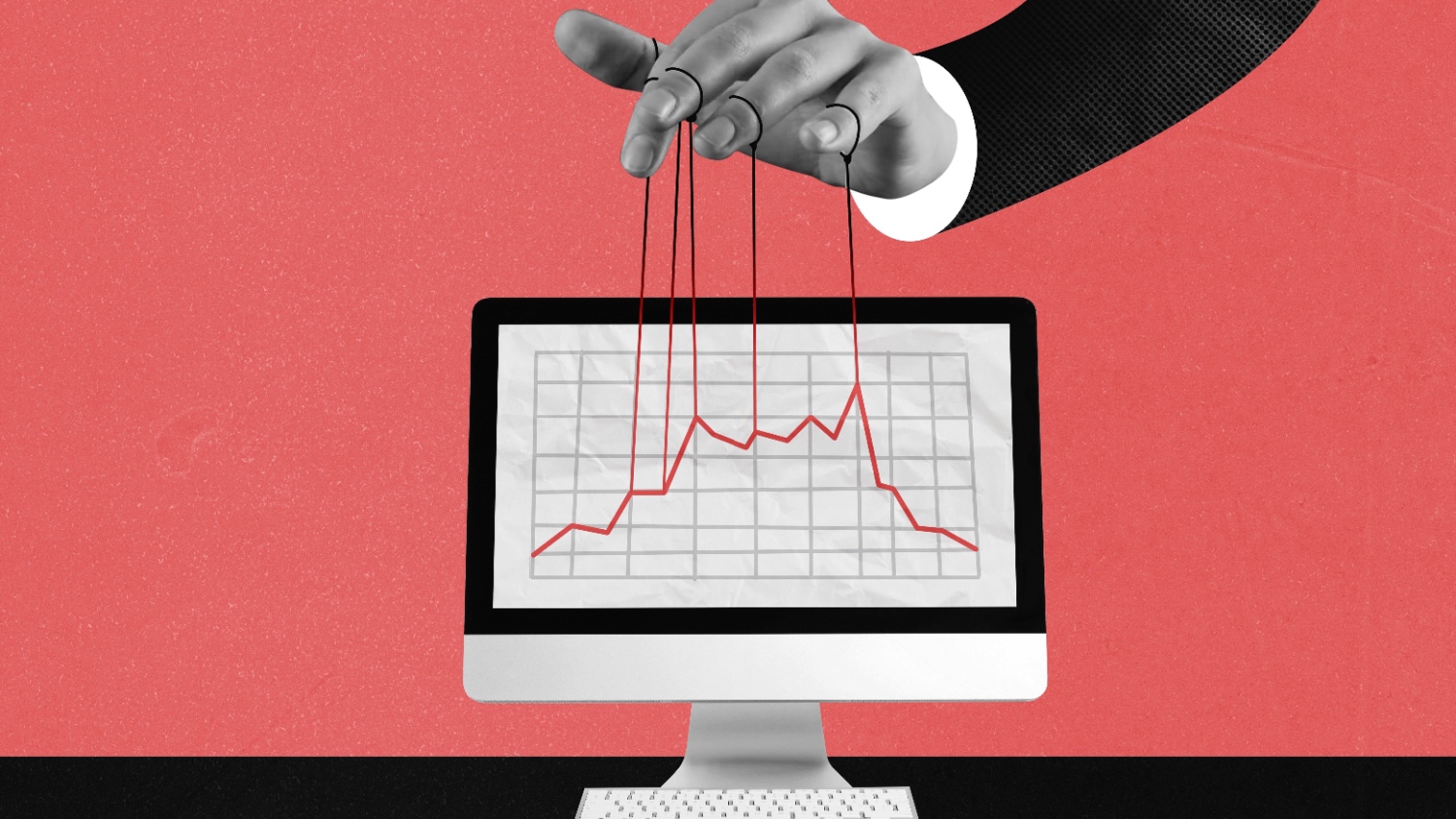National Accounting Leader Shares Real-World Insights
In a recent dialogue with Jenkins MAC students, George R. Botic addressed topics ranging from innovation in auditing practices to the impact of new technology. Here, we share his insights and expertise.

Poole College of Management Master of Accounting (MAC) students welcomed George R. Botic to their Advanced Auditing class, where he shared his knowledge and insights through a lively Q&A session.
Botic, a prominent thought leader in the accounting profession, was appointed as a board member of the Public Company Accounting Oversight Board (PCAOB) by the U.S. Securities and Exchange Commission in 2023. According to its website, the PCAOB “regulates the audits of public companies and SEC-registered brokers and dealers in order to protect investors and further the public interest in the preparation of informative, accurate, and independent audit reports.”
Botic is a Certified Public Accountant (CPA) who worked with the PCAOB for two decades prior to becoming a board member. He holds a Bachelor of Science in accounting from Shepherd University and a Master of Accountancy from Virginia Tech.
Through his exchange with MAC students, Botic noted they are “the future of the profession” and covered topics ranging from the role of the PCAOB to the impact of new technology on the accounting profession. Here, we share his insights and expertise. (Answers have been edited for clarity and brevity.)
How does the PCAOB balance the need for innovation in auditing practices with the necessity for stable and reliable standards?
Finding the right balance with technology and stability is a challenge for all regulators, as they usually take retrospective, not prospective, views on issues. In our case, the accounting firms are leading the technology development charge. We are moving along with them, providing them with our feedback when it makes sense. We strive to be aware of, understand and evaluate the technological advances of firms and then consider the implications on our oversight activities, primarily our standard-setting and rule-making efforts.
From my perspective, we need to develop flexible standards that will stand the test of time. We don’t want to be in the position where, every time a new technology appears, we must create a new standard. There may be times when technology changes so much that we must take action. But the goal is to develop standards with enough elasticity they can ebb and flow with advances in technology.
In light of emerging technology and data analytics, how is the PCAOB adapting its strategy to address potential audit challenges and opportunities?
We’re living in a very fluid world when it comes to this topic. I suspect there have been more advances in technology in the last 24 months than in the prior 20 years, and the major accounting firms’ investments in technology are astonishing. Our challenge, and I think this is a challenge for all regulators, is how best to keep up.
The PCAOB has some advantages in this area. Most of the technology is being driven by a small number of firms. I think our role is to stay up-to-date with the actions those firms are taking and ensure we understand as much as we can before they implement new technologies.
I feel strongly that the PCAOB shouldn’t inhibit development. I ask myself, what should be the PCAOB’s role? Should we encourage firms to develop or adapt new technologies, or simply serve as a referee? This is a big philosophical question with differing views on what our role should be. We’re watching these developments, and we should be able to look back in one to three years and have a clearer picture.
What types of sources and/or statistics are used to gauge what the most pressing issues in the marketplace are for the year, to then perform the inspections about those issues?
Because our inspection program is mainly risk-based, our primary driver for issuer selection and focus areas within a selected audit file is our assessment of key risks. But we also have a random element for selecting issuers. For the major firms, the random piece varies from year to year. It has been as high as 50% of the audit files inspected, but currently is about 20% with the remaining selection chosen based on risks.
Considering risk-based selections, we focus on macroeconomic conditions. What are the current risks to companies in all sectors? These are the risks you’re reading about through various news outlets: high inflation, high interest rates, a slowing economy, supply chain issues. These risks could also reflect movements or swings in oil and gas prices, or they could include the impact of geopolitical events such as the conflicts in Ukraine and Israel. We consider how these risks impact the issuers and may drive behaviors and motivations. For example, in a year when results don’t meet expectations, companies may artificially inflate revenue. We think about those risk areas as well as how the auditor’s response to those risks.
We then take a second pass focused on industry risks. We ask whether there are certain industries that might be more adversely impacted by some of these trends, for example oil and gas companies, technology companies, or automobile manufacturers with supply chain issues. In addition, we focus on emerging issues, such as cryptocurrencies.
As a final consideration, we look at the firm’s characteristics. We have years of inspection data on firms, offices, and even individual partners. For example, we may have experience with one office of a firm that always has a problem, while another office of that same firm is always clean as a whistle. That history will also influence our thinking as we develop our selections.
From a conceptual level, we aim to be like the “cop on the beat.” When the officer is on the ground in the community each day, you’re less likely to jaywalk. And we hope, at least conceptually, that the random aspect of a portion of our selections, and the corresponding element that any single engagement is subject to inspection, keeps everyone on their toes.
How does the PCAOB work with other global regulators, and how do you determine similarities and differences in relation to those other regulators?
At times, there can be conflicts between our requirements and those of the other jurisdiction. In the U.S., the Sarbanes-Oxley Act mandates certain requirements. Separately, unlike almost all regulators, the PCAOB has an extraterritorial reach. Most regulators can inspect firms in their home country, but don’t have the authority to inspect outside of that country. For example, a local regulator can inspect audit work performed for issuers located in that country, but not the work of a subsidiary performed in Mexico. In contrast, we are able to inspect any registered firm that performs audits or a substantial role in the audit of companies listed in the U.S.
Building strong relationships with other regulators takes time. Ten years ago, many foreign regulators were not keen to have us inspect in their countries. Our Office of International Affairs has negotiated practical solutions in terms of what our inspectors and enforcement staff need and how we can do our work in other jurisdictions. It’s not always easy and it takes work, but we keep at it until we are able to find ways to meet our mandate while respecting and complying with the laws of the other jurisdictions.
Much of this comes down to trust. Some countries have been suspicious of our activities. Over time, they have developed trust in our inspectors and our process, and we have demonstrated our people will be good guests and good visitors in their country.
As an aside on this topic, for future career considerations, if you like to travel internationally and you like the technical aspects of auditing and accounting, the PCAOB is a great place to work. We’ve got folks that, in some cases, will spend six weeks in Paris or Zurich reviewing audit files. Some inspectors even travel to other locations on weekends from the city where they are performing an inspection. While language skills are a plus, we use professional translators when necessary.
At what point in an accountant/auditor’s career do they usually pursue employment with the PCAOB? Are most hires more experienced or experts in a certain area of accounting/auditing? Is there a particular path to follow in order to qualify as a candidate?
From an inspections perspective, which constitutes about half of all PCAOB employees, we typically hire first-year managers with six to seven years of experience. We believe that, in order to be an effective inspector, you need to understand the nuts and bolts of executing an audit, because that is hard to train without the practical experience.
We look for individuals who have performed audits, supervised staff, and interacted with C-suite executives during the course of an audit. And then, ultimately, people with the confidence and assurance to go toe-to-toe with major partners at accounting firms and dig into the work that is performed. Not to say the role is contentious, and we don’t want it to be, but our inspectors need to be comfortable asking uncomfortable questions in what can be a challenging environment. Because there is a lot at stake: individuals’ performance evaluations, salary adjustments, reputations, and in some cases, even careers can be on the line.
Other divisions of the PCAOB, such as our Office of the Chief Auditor, hire at other levels, but not as many individuals as the Division of Registration and Inspections. New employees in other divisions may be a bit more junior, but would have expertise in a particular area, such as revenue.
We also offer internships throughout the year for undergraduate, graduate, and Ph.D. students. We have some wonderful opportunities, including some in our Office of Economic and Risk Analysis. I believe our interns gain a lot in terms of broader thinking about risk and how the PCAOB thinks about risk.
- Categories:


